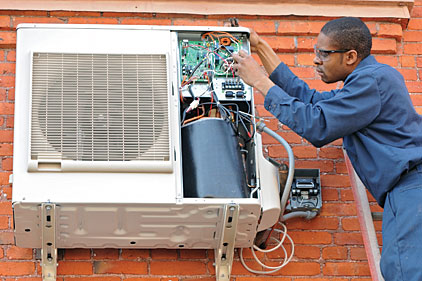While ductless mini-split style systems are very common in major markets within Asia and Europe, they have not made significant penetration into the United States. In spite of the recent growth in the U.S. market, they still only represent around 5 percent of the U.S. unitary air conditioning market. This low penetration is probably due to the huge installed base of larger U.S.-style homes and businesses that already have ductwork in place.
Also, with the decline of new construction in the U.S., air conditioning purchases have been dominated by system replacements. And when an air conditioner needs to be replaced, it is usually easier and less expensive to continue using the existing ductwork and just replace the system with a traditional outdoor unit and indoor coil or air handler. Still, there are obviously some situations where ductless solutions make sense.
Common Applications
In an effort to gain a better understanding of these trends, Emerson Climate Technologies conducted a review of available industry data, conducted several market studies, and held discussions with several major OEM customers. This research revealed some hints about where these ductless systems are being applied. For example, over half of all the ductless systems installed were 1.5 hp and below (less than 22,000 Btuh) and the majority were 2 hp and below (less than 27,000 Btuh). Further insight can also be gleaned from the fact that over two-thirds of all ductless installations were done with single evaporator models.
In addition to industry data, further research from a survey of over 800 U.S. contractors conducted by Emerson Climate Technologies last fall indicates that approximately 85 percent of all ductless systems were probably installed in commercial applications. From these facts, one could conclude that the most common ductless mini-split applications in the U.S. would typically be those going into single space, commercial buildings and, to a lesser extent, some suitable ductless applications in small residential spaces such as those involving room additions or smaller, zoned apartments.
Ductless Trade-offs
Emerson Climate Technologies made ductless mini-splits a subject of a recent roundtable event involving 55 leading air conditioning contractors and wholesalers from around the United States. Discussions with this group supported the survey results, which indicated the top benefits of ductless systems included ease of installation/no ductwork, zoning capability, and flexibility within the design space.
These benefits seem to make sense and would be consistent with the industry facts listed above as many contractors would be using these systems in commercial spaces which do not already have ductwork and/or might be difficult to retrofit with new ductwork. Add-on spaces in either residential or commercial locations which are out of reach from existing HVAC service would be ideal for ductless mini-splits.
Some of the top concerns about duct-free systems listed by the survey respondents and supported by the roundtable discussions included indoor airflow and air quality (including outdoor make-up air), ease of service/troubleshooting for technicians, higher-than-expected costs and some concerns about general appearance — probably related to the wall-mounted or ceiling-mounted evaporator units that are typical in Asia and Europe but are not common in the U.S.
Clearly, duct-free air conditioning provides good, economically sound solutions for smaller spaces which have no existing ductwork, and sales of these systems into U.S. applications will likely continue to grow to meet this demand. However, the application of ductless systems into larger spaces and new construction spaces involving multiple ductless units will be faced with certain challenges including relative cost, airflow quality, humidity control, and condensate management.
Although ductless systems offer many benefits, understanding the real economic and comfort trade-offs in various applications will be essential to making good decisions about where to apply ductless solutions.
Sidebar: Ductless System Tradeoffs
Ductless Benefits
• Ease of installation
• No ductwork needed
• Flexibility in design space
• Zoning capability
• Low sound
Ductless Concerns
• Indoor air quality
• Outdoor make-up air
• Serviceability
• Costs higher than expected
• Appearance issues
Publication date: 04/23/2012


Report Abusive Comment